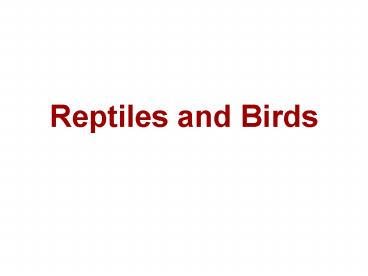Reptiles and Birds - PowerPoint PPT Presentation
1 / 56
Title:
Reptiles and Birds
Description:
Class Mammalia. Class Mammalia. Hair. Mammary glands. Sweat ... Class Mammalia. Movable eyelids. Two occipital condyles. Three ear bones. Muscular diaphragm ... – PowerPoint PPT presentation
Number of Views:53
Avg rating:3.0/5.0
Title: Reptiles and Birds
1
Reptiles and Birds
2
Class Reptilia
- Scales
- Amniotic egg
- One occipital condyle
- Ectothermic
- Three chambered heart
- Claws
3
Amniotic Egg
4
Order Testudines
- No teeth in adult
- Shell
- Anapsid
5
Turtle Shell
Carapace
Plastron
6
(No Transcript)
7
Order Squamata
- Kinetic skull
- Movable joints
- Lizards
- Snakes
- Dinosaurs
8
Green Iguana
- Ornamental crest
- Five feet long
- Tropical rainforest
- Mexico
- South America
- Omnivores
9
Komodo Dragon
- Attack and eat humans
- 10 feet long
- 300 pounds
- Indonesia
10
Snakes
- No legs
- No external ears
- Jacobsons organ
- Sense smell with aid of tongue
- Cornea of eye protected with a spectacle
- transparent membrane
- Skull bones loose
- Swallow large prey
11
(No Transcript)
12
Order Crocodilia
- Crocodiles
- Caimans
- Alligators
- Gavials
- Elongated skull
- Four chambered heart
13
Alligator
Caiman
Crocodile
Gavial
14
Class Aves
15
Class Aves
- Feathers
- No teeth
- Flexible long neck
- One occipital condyle
- Scales on legs
- Bones with air spaces
- Endothermic
- Four chambered heart
16
Adaptations for Flight
- Honey combed bones
- Air cavities
- Less weight
17
Adaptations for Flight
- Enlarged sternum
- Flight muscle attachment
- Long neck
- balance
18
Adaptations for Flight
- Wing
- lift
19
Adaptations for Flight
- Reduce body weight
- No teeth
- No urinary bladder
- No penis
- Only one ovary
20
(No Transcript)
21
(No Transcript)
22
Digestive System
- Crop
- Storage
- Proventriculus
- Enzymes
- Gizzard
- Grind food
- Cloaca
- Waste
- Reproduction
23
Vision
- Up to 8 times keener than human vision
- Each eye moves indendtantly
24
Respiratory System
- Nine air sacs
- Connect to lungs and centers of bones
- Cools the bird
- Fresh air always moving
- No dead ends as in mammals
- Each wing beat moves air
- Never run out of air
25
Bird Classification
- 28 orders
- 9600 species
26
Class Mammalia
27
Class Mammalia
- Hair
- Mammary glands
- Sweat glands
- Diphyodont teeth
- Two sets
- Heterodont teeth
- Different shapes and functions
28
Class Mammalia
- Movable eyelids
- Two occipital condyles
- Three ear bones
- Muscular diaphragm
- Placenta
- Except two groups
- Endothermic
- Four chambered heart
29
Fig. 48.28
30
Therapsids
- Body raised off the ground
- Limbs more under the body
- Teeth differentiated into 3 types
- Secondary palate developing
- Phalangeal formula develops 2-3-3-3-3
Lystosaurus
31
Early Mammals
- Triassic
- 220 MYA
- Small
- Hair
- Mammary glands
- Skin glands
- Molar teeth
Megazostrodon
32
Basic Mammal
33
Classification of the Bones
- The 206 bones of the human may be classified
according to their shape or whether they are in
the axial skeleton or appendicular skeleton. - Shapes include long bones, short cube-shaped
bones, flat bones, round bones, and irregular
bones such as vertebrae. - The bones are not smooth but have knobs and
processes where muscles attach.
34
The skeleton
35
Same bones, different stance
36
(No Transcript)
37
Digestive system
38
(No Transcript)
39
Path of blood through the heart
40
Cardiovascular system diagram
41
Bats
- Only flying mammal
- Seed dispersal
- Pollination
- Control insects
42
Whales
- Blue whale
- 100 feet long, 120 tons
- 9 story building
- Loudest animal 188 dB
- Sound travels 100s of miles
43
(No Transcript)
44
Blue Whale
- Baleen whale
- Eats krill
- Tiny crustaceans
- 400 pounds/day
- Heart weighs 1000 pounds
- Size of a Volkswagen
- Endangered species
45
(No Transcript)
46
Monotremes
- Lay eggs
- Incubate 12 days
- Lick milk from mothers fur
- Transitional species
47
Marsupials
- Pouched mammals
- Birth to tiny embryo
- Embryo attaches to mothers nipple to complete
development
48
Placental Mammals
- Placenta nourishes embryo
- Long gestation period
- 22 months for elephant
- Most successful group of mammals
49
Placental Mammals
- Competitive advantage over monotremes and
marsupials - Better nutrition from placenta
- Less vulnerable to predators
- More advanced at birth
50
Evolution of Placenta from Amniotic Egg
- Reptile
- Chorion
- Oxygen from air
- Amnion
- Provides private pond
- Yolk Sac
- Food for embryo
- Allantois
- Store urinary waste
- Mammal
- Chorion
- Form placenta to get oxygen food from mothers
blood - Amnion
- Provides private pond
- Yolk sac
- Temporarily make RBCs
- Allantois
- Form umbilical cord
51
(No Transcript)
52
Mammal Classification
- 14 major orders
- Over 4,000 species
- About half are rodents
53
Order Monotremata
- Lays eggs
- Young lick milk from mothers fur
54
Order Marsupiallia
- Pouch
55
Order Primates
- Opposable thumb
- Binocular vision
- Fingernails usually
- Mammary glands reduced to one thoracic pair
56
The End































